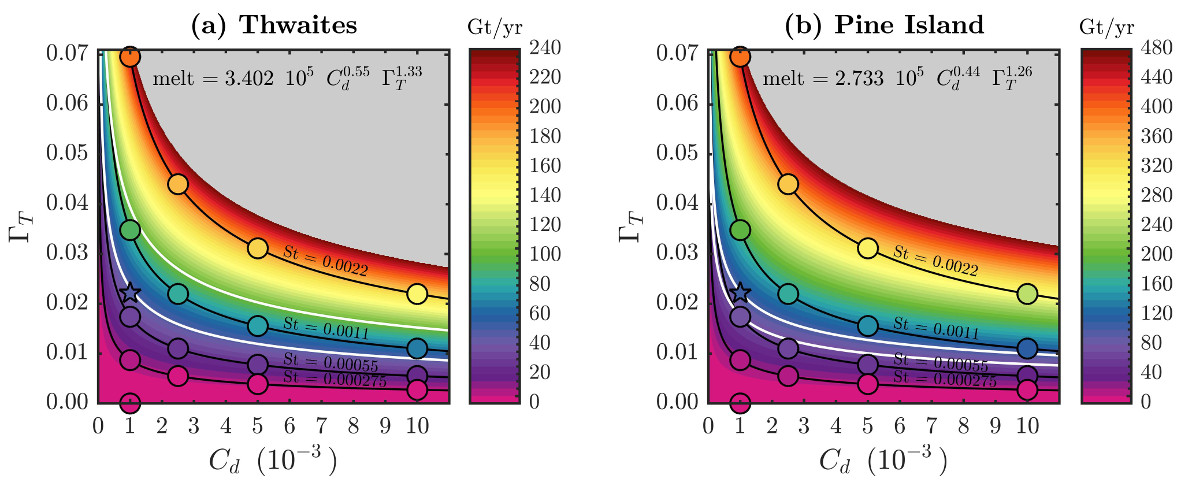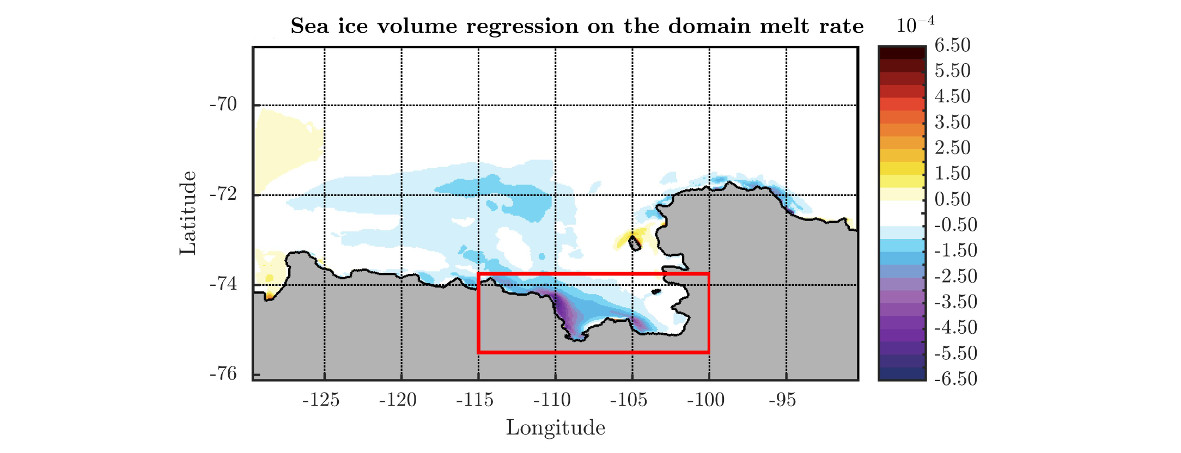Ocean circulation and sea-ice thinning induced by melting ice shelves
This is the first paper from the TROIS AS ANR project, and the first paper written at IGE/CNRS/UGA (with colleagues from Australia, UK and USA) on the simulation of under-ice-shelf seas. Here is the journal link.
In this paper, we describe a new configuration of the ocean model NEMO that represents the entire Amundsen Sea, Antarctica, including ice-shelf cavities, and the entire sea ice pack extending northward of the Amundsen Sea. After an evaluation of our simulations (based on satellite estimates of sea-ice cover and ice-shelf melt, and on CTD profiles), we have investigated the sensitivity of ice-shelf melt to the drag (Cd) and heat exchange (Γ) coefficients at the ice/ocean interface. This emphasizes the importance of the thermal Stanton number (St), and shows that several combinations of drag and heat exchange coefficients allow reproducing observed melt rates.
 Sensitivity of the total melt rate in (a) Thwaites and (b) Pine Island cavities to the drag and heat exchange coefficients. Each circle is the result of a simulation, and the colour shading in between is an interpolation. Iso-Stanton numbers are indicated in black, and the white contours indicate the melt observational range.
Sensitivity of the total melt rate in (a) Thwaites and (b) Pine Island cavities to the drag and heat exchange coefficients. Each circle is the result of a simulation, and the colour shading in between is an interpolation. Iso-Stanton numbers are indicated in black, and the white contours indicate the melt observational range.
Then, we have used all these sensitivity experiments to know more about the melt-induced circulation within ice-shelf cavities. Our results indicate a very strong linear relationship between the cavity melt rate and the circulation (either input/output, barotropic, or overturning). The strength of the melt-induced circulation is also quite impressive, as the melt-induced circulation brings 100 to 500 more warm water into the cavity than the melt volume flux itself. The water inflow mixes with the extremely buoyant ice-shelf meltwater, and is still buoyant when it extis the cavity. As such, ice-shelf cavities in the Amundsen Sea are very powerful warm water pumps.

Schematic of the melt-induced circulation and heat fluxes in the cavities of the Amundsen Sea. All the numbers correspond to volume and heat transports induced by 1mSv (1000 m3/s) of melt rate.
In terms of heat, the melt-induced inflow typically brings 4 to 20 times more heat into the Amundsen Sea cavities than the latent heat required for melt. Our simulations indicate that only 6% to 31% of the heat that enters a cavity with melting potential is actually used to melt ice shelves. This makes a lot of extra heat that is transported upward by the ice-shelf pump. In other words, the ice-shelf pump transports heat from Circumpolar Deep Waters (CDW) to the ocean surface. Our simulations indicate that more ice shelf melt therefore induces less sea ice volume near the ice sheet margins.
 Regression of mean sea-ice thichness on the domain ice-shelf melt rate (units: m3 of sea ice per m2 per Gt/yr). The ice-sheet is in gray.
Regression of mean sea-ice thichness on the domain ice-shelf melt rate (units: m3 of sea ice per m2 per Gt/yr). The ice-sheet is in gray.
Reference
Jourdain, N. C., Mathiot, P., Merino, N., Durand, G., Le Sommer, J., Spence, P., Dutrieux, P. and Madec, G. (2017). Ocean circulation and sea-ice thinning induced by melting ice shelves in the Amundsen Sea. J. Geophys. Res., 122 (3), 2550–2573. doi/10.1002/2016JC012509